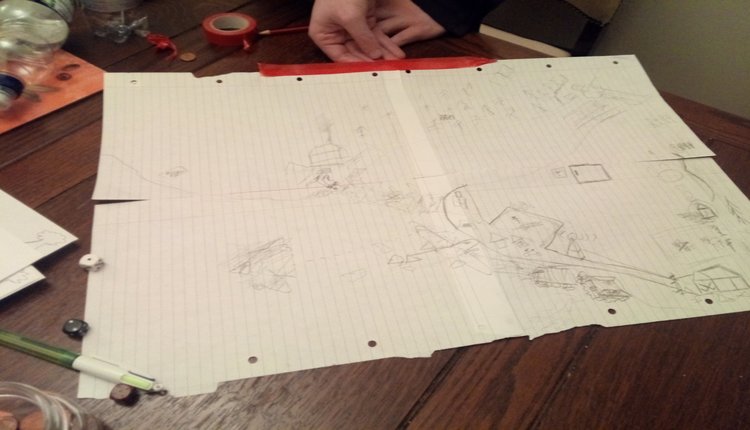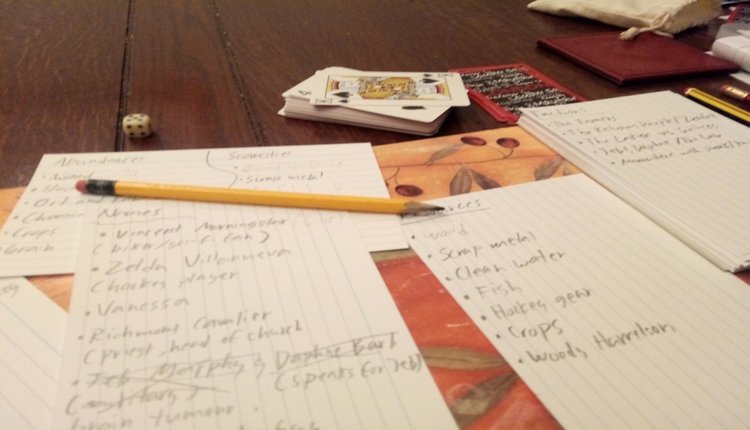Building A Story Together in The Quiet Year
On a small, lakeside community, a glimmer of civilization still lingers. It’s been a promising year for these people. They’ve weathered the end of the world, the destruction of all they held dear. They’ve survived the roving bands of marauders ready to claim the scraps of whatever’s left. They’ve beaten back the Jackals and are ready to concentrate on more than just surviving. The coming year looks good for them. They are ready to thrive.
That’s the opening gambit of The Quiet Year, a tabletop role playing game created by Avery Alder of Buried Without Ceremony. It’s a game about map making and world building, where players come together not to roleplay specific characters but the community as a whole as they strive to get through the hardships of an entire calendar year. No party of adventurers off to distant lands or dungeons, just settling down at a community and see how they get on. It’s a game I became intrigued with after hearing a role playing podcast use it to create the city that they will play in for their next campaign. And just that example shows the flexibility and malleability of this game.

The medium players use in this game is the map. As said in the rules, “It’s fine to draw poorly or crudely but everyone is going to draw.” There is no Dungeon Master. Instead, each player draws from a deck of cards and each card denotes what happens in the week that’s happening, usually some form of defining the landscape (“What is the most beautiful thing in this area?”) or a narrative challenge (“A natural disaster strikes. What is it? Choose either a project fails or several people die.”) The player also chooses to set up projects for the community to finish, discover new things in the area or hold a discussion to get the feel of what the community is thinking about. Through this medium, the story of this community slowly emerges.
And it’s a story that’s different with each game. The framework for The Quiet Year is quite slender, with the PDF being only 15 pages long. The only piece of narrative provided to you is this fragment: “For a long time, we were at war with The Jackals. But now, we’ve driven them off, and we have this – a year of relative peace. Come Winter, the Frost Shepherds may return.” Anything else about the setting of the community i.e. how many people, what the landscape is like, what kind of people lived there, it’s all at the whims of the players.
Of course, sometimes those whims can clash, especially in what is called a GM-less game where no one and everyone is the master of the story. Though “master” may be the wrong word. It’s not that one person has control and everyone else is responding to their say-so. It’s more like the players are collaborators telling the story. Or, like the first game I played, different show runners writing the same TV show somehow, each of their visions clashing together in joyously ruinous ways.
[perfectpullquote align=”full” bordertop=”false” cite=”” link=”” color=”#70006C” class=”” size=”19"]”Many events could be happening all at once and it never feels too cumbersome.”[/[/perfectpullquote]p>
For instance, one player was more concerned with political intrigue and factions within the community playing off each other. His figurehead was a corrupt priest trying to bring their version of order to this group at the expense of others. Another was interested in the survival aspects of the genre and would seed challenges (aggressive miners from across the river) or loot (a military cache with a high-grade sniper rifle) for the community to discover. Myself, I was more interested in creating mysteries and adding science-fiction horror elements that may pay off later (deadly silver creatures in the woods, radio signals that turned people into robots etc.)
Now that may all sound like clashing elements that would make for a desperately unsatisfying TV show. But it’s not a TV show. It’s a role playing game. And the framework allows for differing strands to flow together thanks to the structure of the year. Many events could be happening all at once and it never feels too cumbersome. After all, any community goes through so much, let alone a community and the post-apocalypse.
And it’s absolutely satisfying to see innocuous elements pay off later down the stretch. For instance, an abandoned hockey rink becomes a haven for a young girl to learn about the pleasures of hockey becomes a gateway for children of the community to escape the strictures of their chores and work becomes a Mean Girls-esque rivalry between the all-female teams becomes a massive showdown with the corrupt priests who are trying to prove their dominance by fighting the children at their own game and the rivals having to band together to do so. It cannot be said how utterly joyous it was for the cards to line up so that the showdown happened at the end of summer, as the Galtree Lakers took on the Blessed in an exhibition match for the ages. And for the next card to inaugurate autumn and bring in fresh pain such as winter climes and threatening foes across the river, marking the end of an almost innocent time.

The Quiet Year is an absolute melange of ideas and actions but there was a gloriousness to the messy nature of it all. Every idea introduced into the map was further shaped and complicated on by the others. A character I introduced, a post-apocalyptic biker spreading his love of science-fiction to what’s left of the world named Vincent Morningstar, became a mad soothsayer by the end, driven by a terrible disease. Two guardsmen fell in love as they were trapped on top of a watchtower, cut off by a radio station falling down a waterfall. A box set of Woody Harrelson DVDs became a powerful, totemic reminder of the past world. We were becoming writers, storytellers, eager to move our own plots but also to disrupt others, watching as our best-laid plans morphed into stranger, more captivating ideas.
This is a trend of collaborative role playing, where players get a say in the world rather than just relying on the voice of the GM, that’s been bubbling underneath the surface of the mainstream. Where the emphasis is not on combat or stats or the rules of the world but the story of that world. How characters and setting come together and what happens if they do so. This is definitely more prevalent in GM-less games which are often slender but variable frameworks that allow people to tell a multitude of stories. The second game I played was set in a fantasy western setting, a town on the frontier watched over by centaur sheriffs, visited by travelling elf salesmen peddling their actual snake oil while, in the distance, a dwarven army sets up shop, waiting for the right chance. And much like the first game, events spiral in ways I could never have predicted.
In the end, it’s almost sad to step away from a world lived in by yourself and others. When the Frost Shepherds come, it’s always with a pang. The Quiet Year is a game about building worlds but not by yourself. When it’s a world built with others, bolstered and strengthened by their cooperation, it’s a world that’ll never leave you.

